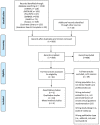Healthcare professionals' perceived barriers and facilitators of implementing clinical practice guidelines for stroke rehabilitation: A systematic review
- PMID: 36475911
- PMCID: PMC10041573
- DOI: 10.1177/02692155221141036
Healthcare professionals' perceived barriers and facilitators of implementing clinical practice guidelines for stroke rehabilitation: A systematic review
Abstract
Objective: To identify healthcare professionals' perceived barriers and facilitators to clinical practice guideline implementation within stroke rehabilitation.
Data sources: CINAHL, MEDLINE, EMBASE, AMED, Cochrane library, Academic Search Complete and Scopus. Additional papers were identified through hand searching.
Review methods: The review followed the Preferred Reporting Item for Systematic Reviews and Meta-Analysis Protocols systematic review approach. Any empirical research that provided qualitative data on healthcare professionals' perceived factors influencing clinical guideline implementation in stroke rehabilitation was included. One reviewer screened all titles and abstract reviews (n = 669). Another two reviewers independently screened 30% of title and abstract reviews, followed by full-text reviews (n = 61). Study quality was assessed using the mixed-method appraisal tool.
Results: Data from 10 qualitative, six quantitative and six mixed-method studies published between 2000 and 2022, involving 1576 participants in total, were analysed and synthesised using modified thematic synthesis approach. The majority of participants were therapists n = 1297 (occupational therapists, physiotherapists, speech and language therapists). Organisational factors (time constraints, resources) alongside healthcare professionals' lack of knowledge and skills were the most cited barriers to guideline implementation. Contradictory attitudes and beliefs towards stroke guidelines applicability to real-life clinical practice and their evidence base were reported. Organisational support in the form of training, local protocols, performance monitoring and leadership were reported as perceived facilitators.
Conclusion: Barriers and facilitators are multifactorial and were identified at guideline, individual, team and organisational levels. There is a need to translate perceived barriers and facilitators into implementation interventions especially addressing organisational-level barriers.
Keywords: barriers; clinical practice guideline; facilitators; healthcare professional; stroke rehabilitation.
Conflict of interest statement
The authors declared no potential conflicts of interest with respect to the research, authorship, and/or publication of this article.
Figures
Similar articles
-
Increasing the uptake of stroke upper limb guideline recommendations with occupational therapists and physiotherapists. A qualitative study using the Theoretical Domains Framework.Aust Occup Ther J. 2019 Oct;66(5):603-616. doi: 10.1111/1440-1630.12599. Epub 2019 Jul 23. Aust Occup Ther J. 2019. PMID: 31338859
-
Beyond the black stump: rapid reviews of health research issues affecting regional, rural and remote Australia.Med J Aust. 2020 Dec;213 Suppl 11:S3-S32.e1. doi: 10.5694/mja2.50881. Med J Aust. 2020. PMID: 33314144
-
Factors influencing allied health professionals' implementation of upper limb sensory rehabilitation for stroke survivors: a qualitative study to inform knowledge translation.BMJ Open. 2021 Feb 19;11(2):e042879. doi: 10.1136/bmjopen-2020-042879. BMJ Open. 2021. PMID: 33608401 Free PMC article.
-
Barriers and Facilitators to Aerobic Exercise Implementation in Stroke Rehabilitation: A Scoping Review.J Neurol Phys Ther. 2020 Jul;44(3):179-187. doi: 10.1097/NPT.0000000000000318. J Neurol Phys Ther. 2020. PMID: 32516297
-
Individual, health system, and contextual barriers and facilitators for the implementation of clinical practice guidelines: a systematic metareview.Health Res Policy Syst. 2020 Jun 29;18(1):74. doi: 10.1186/s12961-020-00588-8. Health Res Policy Syst. 2020. PMID: 32600417 Free PMC article.
Cited by
-
Acute Stroke Units Nested within Broader Neurology: Care Bundles for Nursing to Enhance Competence and Interdisciplinary Coordination.Curr Neurol Neurosci Rep. 2025 Mar 6;25(1):21. doi: 10.1007/s11910-025-01409-7. Curr Neurol Neurosci Rep. 2025. PMID: 40047971 Free PMC article. Review.
-
Evidence synthesis of health policy and systems research in rehabilitation: a protocol for Cochrane overviews of systematic reviews on delivery, governance, financial arrangements, and implementation strategies.Eur J Phys Rehabil Med. 2025 Apr;61(2):335-350. doi: 10.23736/S1973-9087.24.08833-6. Epub 2025 Jan 27. Eur J Phys Rehabil Med. 2025. PMID: 39869129 Free PMC article.
-
Shaping corticospinal pathways in virtual reality: effects of task complexity and sensory feedback during mirror therapy in neurologically intact individuals.J Neuroeng Rehabil. 2024 Sep 4;21(1):154. doi: 10.1186/s12984-024-01454-2. J Neuroeng Rehabil. 2024. PMID: 39232841 Free PMC article.
-
Using a tablet to understand the spatial and temporal characteristics of complex upper limb movements in chronic stroke.PLoS One. 2024 Nov 18;19(11):e0311773. doi: 10.1371/journal.pone.0311773. eCollection 2024. PLoS One. 2024. PMID: 39556594 Free PMC article.
-
Stroke Rehabilitation Clinical Practice Guidelines in Low- and Middle-Income Countries: A Systematic Review of Quality and Unique Features.Cerebrovasc Dis. 2025;54(4):429-440. doi: 10.1159/000539999. Epub 2024 Aug 2. Cerebrovasc Dis. 2025. PMID: 39097962 Free PMC article.
References
-
- Brusamento S, Legido-Quigley H, Panteli D, et al. Assessing the effectiveness of strategies to implement clinical guidelines for the management of chronic diseases at primary care level in EU member states: A systematic review. Health Policy 2012; 107: 168–183. - PubMed
-
- Hubbard IJ, Harris D, Kilkenny MF, et al. Adherence to clinical guidelines improves patient outcomes in Australian audit of stroke rehabilitation practice. Arch Phys Med Rehabil 2012; 93: 965–971. - PubMed
-
- Cadilhac D, Ibrahim J, Pearce D, et al. Multicenter comparison of processes of care between stroke units and conventional care wards in Australia. Stroke 2004; 35: 1035–1040. - PubMed
-
- Duncan PW, Horner RD, Reker DN, et al. Adherence to post-acute rehabilitation guidelines is associated with functional recovery in stroke. Stroke 2002; 33: 167–178. - PubMed
Publication types
MeSH terms
LinkOut - more resources
Full Text Sources
Medical



